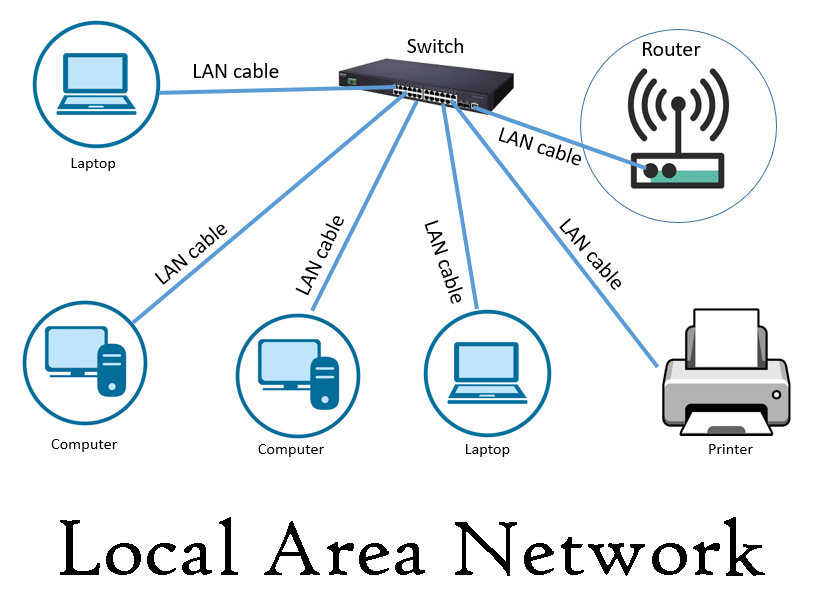Definition of local area network (LAN)
A network that is used to connect computers in a single building or group of buildings. A computer in LAN may be a PC, laptop, embedded computer or mobile computer like smartphone, tablet, and smartwatch.
An experiment of connecting computers over LAN had started in the 1970s. In older days printers and other storage devices were very expensive. So these devices were shared among different users in the local area network. From 1983, all computers in the LAN network started sharing their resources.

What is virtual LAN
Virtual LAN is a group of computers that are partitioned while connecting to the switch. Suppose you have a switch and there are 4 ports attached and 4 computers are connected to the ports. Now one computer is grouped as the HR department. And three computers are grouped as services department. This means there are two virtual LAN in the switch. One is the HR group of virtual LAN and the other is services group of virtual LAN. Now the benefit of this partition is that if any group broadcast then that will only be reached to that department. So the HR department will broadcast to only HR department computers. This is a virtual division of computers in the LAN. Virtual LAN also helps to protect the departments from hackers. If any group is attacked by the hackers then another department will be safe from the hackers because that belongs to another group in virtual LAN.
Local area network can be either wired LAN or wireless LAN.
1) Wired local area network
Wired LAN is also known as Ethernet LAN connection. In this type of connection, wires are used to connect the computers. It is a fast connection and latency is low in a wired connection. Latency means when you transfer data then in how much time it is received to the destination. So data reach time is low in wired LAN. In industries, Ethernet LAN is used because in this case data is not lost and each user gets a dedicated line for transferring the data. Ethernet speed is about 1Gbps. Different types of equipment are used in wired LAN e.g. modem, switch, hub, router, coaxial cable is used to make wired LAN connection.
2) Wireless local area network
Wireless LAN is also known as a Wi-Fi connection. It has low speed as compared to wired LAN. The speed of Wi-Fi is below 1 Gbps. Wi-Fi follows IEEE 802.11 standards. The latency rate is high in wireless LAN that means data transfer time from one location to other is high. There is a high chance that your data collapse with the other data i.e. the signals may collide with each other if many devices are sending and receiving data wirelessly. If you are interested to play games then I suggest you use a wired connection because it has a low latency rate as compared to Wi-Fi. You can use a Wi-Fi hotspot to connect different devices in a wireless LAN. There are no wires needed to make a wireless connection. The equipment used to make the wireless connection is a wireless modem, wireless router, wireless network card.
LAN can be categorized into two types. Computers in LAN are either connected in the form of peer to peer or client-server.
1) Peer to peer network
In Peer to peer (P2P) network computers are directly connected through a hub or switch. There is no dedicated server in the P2P network. Each computer in the network acts as a client and server at the same time. An example of a P2P network is BitTorrent in which one computer uploads files and other computers download files. When each computer downloads some part of the files then it also behaves as a server and uploads the files also. Network security is weak in the P2P network. In the P2P network, upto 10 computers are connected.
2) Client-server network
In a client-server network, one computer acts as a server and other computers act as clients. The server can be either of file server, print server, or database server. Network security is high in a client-server network. The speed of the client-server network is high than peer to peer network. If you are watching any video on YouTube then your machine will behave as a client and the YouTube website will behave as a server.
Network topologies
The way in which network connections is made between computers is known as network topology. It is the physical layout of the network. In network topology location of computers in the network and how cables are connected to the computers.
There are different types of network topology that include:-
- Bus topology
- Star topology
- Ring topology
- Tree topology
- Mesh topology
- Hybrid topology
Features of local area network (LAN)
Some features of LAN are:-
- Hundreds or thousands of computers may be connected through LAN
- Data transmission speed in LAN range from 1 Mbits/sec to 100 Mbits/sec
- The data transmission rate in LAN is faster than common telephone lines
- You can save money by using software shared in the LAN network and you don’t need to buy a separate license for each user in the network
- Data can be stored in a centralized server and retrieving backup from the server is easy for every computer connected to the network
- Data security is well managed in LAN where the administrator of the network controls all the security of the network and the administrator looks after the security of all the devices connected to the network.
- Data and information can be shared among computers in the network.
- Resources like printers, hard drive, DVD writer, USB Drive, Fax machine, Scanner and software can be shared with all the devices connected to the network.
- A local intranet can be set up in the LAN. Web pages can be then shared among users of the LAN network.
- The performance of some application can be improved by distributing tasks among different computers in the LAN.
- Users in LAN can also send/receive emails from each other
- Sharing a single internet connection over the LAN helps every user in the network to access the internet. You can also set an internet bandwidth limit for every user in the network. Any organization can purchase a high bandwidth internet and then all the employees of the organization can use the same internet connection.
Examples of local area network (LAN)
- In the internet club, the same internet connection is shared with all the computers in the network.
- Students in the computer lab can share data, files and software through LAN.
- BitTorrent


















